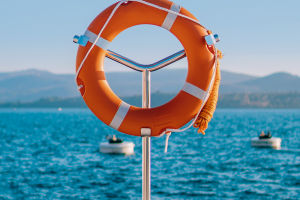Ships, the large vehicles that ply the oceans, from ancient wooden sailing ships to modern giant freighters and luxury cruise ships, are fantastic engineering marvels.
Although they weigh thousands or even tens of thousands of tons, they still float gracefully on the water.
The principle behind this phenomenon comes down to the combined application of buoyancy, hull design, and materials science.
Archimedes' Principle
The primary theory explaining ship buoyancy is Archimedes' principle. Archimedes' principle states that an object immersed in a liquid experiences an upward buoyant force equal to the weight of the fluid displaced by the object.
But, when a ship enters the water, it displaces a corresponding volume of water. The upward buoyant force generated by the displaced water must equal or exceed the weight of the ship, causing the boat to float.
For example, a giant cargo ship loaded with goods enters the water. At this point, the ship's total weight increases, but it also displaces more water. As a result, the ship gains enough buoyancy to support its weight and the weight of its cargo, allowing it to float on the water.
Hull Design and Buoyancy Distribution
The design of a ship plays a crucial role in ensuring its buoyancy and stability. The shape and structure of the hull are precisely calculated and designed to ensure it has sufficient buoyancy and stability in the water.
Modern ships are often designed with a wide bottom and tall sidewalls, a shape that helps increase displacement and, thus, buoyancy. Additionally, the hull's interior is usually divided into multiple watertight compartments.
Even if one compartment is flooded, the other compartments can remain dry and provide sufficient buoyancy to prevent the ship from sinking. This design significantly improves the safety and stability of the vessel.
Materials Science and Construction Technology
Material selection and construction techniques greatly affect a ship's buoyancy and durability. Modern ships are typically built using high-strength steel and alloys.
These materials not only have high strength and corrosion resistance but also can distribute weight effectively through proper design, ensuring that the hull can balance buoyancy and its weight in the water.
With advancements in technology, composite materials are increasingly used. These materials are generally lighter and have excellent strength and durability, allowing ships to reduce their weight while still being able to withstand enormous loads.
This results in a more even distribution of buoyancy, further improving the stability and safety of the vessel.
Center of Gravity and Stability
A ship's center of gravity and stability are other crucial factors. If a ship's center of gravity is too high, there is a risk of capsizing. Therefore, ship designers aim to lower the ship's center of gravity to ensure it remains stable in various sea conditions.
Designers can lower a ship's center of gravity by placing weights at or near the bottom of the boat. These heavy objects are often called ballast.
Modern ships can also dynamically adjust their center of gravity and stability by adjusting the amount of water in their ballast tanks. Ballast tanks can change the weight distribution of the hull by pumping in or removing water to adapt to different sailing conditions.
Conclusion
In conclusion, ships can float and not sink to the bottom despite weighing thousands or even tens of thousands of tons due to the combined application of scientific principles, engineering design, and modern technology.
These factors work together to enable modern ships to sail freely across the vast oceans while shouldering the heavy responsibilities of global trade and transportation.
These engineering marvels not only showcase human wisdom and innovation but also vividly reflect the advancements in modern science and engineering technology.


